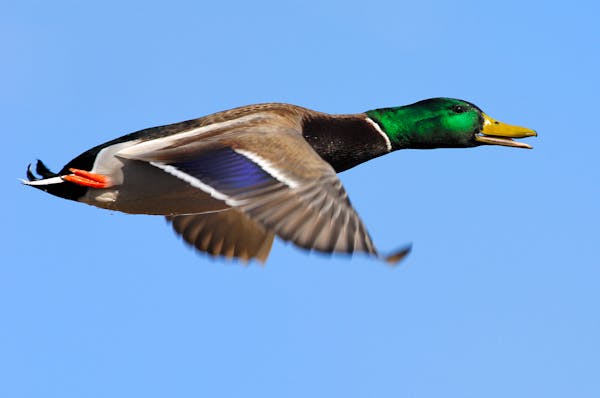ABERDEEN, S.D. – The rooster, cackling in protest, erupted from a patch of cattails and high-tailed it across the prairie toward the setting sun.
I shouldered my 12 gauge and fired, then squeezed the trigger again, blasting the tops off cattails. A third shot, offered mostly in frustration, was futile, too, and the bird disappeared, unscathed.
My Lab looked at me quizzically, waiting for a retrieve command.
"No bird," I told her.
We were on Day 2 of our annual five-day pheasant hunting excursion to South Dakota, and we weren't seeing enough ringnecks to afford such easy misses. Bone-dry fields, summerlike temperatures near 70, stiff winds and a pheasant population that appeared to be down significantly made for some tough hunting.
Our group of four bagged five birds on the opener Saturday, and five Sunday — well below normal but in line with what other hunters found opening weekend. State officials reported hunters in central South Dakota averaged about one bird apiece, and less than one bird in the northeast. They averaged two birds in some south-central hot spots.
"We've always done better," said Tim McMullen, 60, of Delano. "And we've usually shot better, too."
For us and about 20,000 other Minnesotans, pheasant hunting in South Dakota is a tradition. Yes, we come because the state has long been No. 1 in pheasants, and usually we see or flush boatloads of birds.
But, after 30 years of hunting here, shooting lots of birds no longer is the prime attraction.
"It's not why I come," McMullen said. "I come for the hunt. Watching the dogs work."
For our group, it's the entire experience: Hiking vast expanses of grasslands. Eating lunch on the tailgate of a pickup. Chatting with waitresses at small-town restaurants. Savoring a cold beer in a motel room, our tuckered dogs on our beds. Sharing tales from hunts long ago.
"It's the camaraderie, working with the dogs," said Mike Porter, 61, of Minneapolis. "But it's certainly nice when we get birds."
Pheasant hunting concerns
Long blessed with oodles of prime pheasant habitat and near-perfect weather, South Dakota is the envy of other pheasant states. Every October, tens of thousands of out-of-state hunters flood the state.
"Welcome hunters" signs are ubiquitous in towns large and small. Hunters in blaze orange stroll through motels, groceries, taverns and restaurants.
And pheasants mean big bucks, bringing in an estimated $154 million to South Dakota last fall.
But dramatic loss of habitat in recent years has tarnished South Dakota's reputation and threatens its stranglehold as a pheasant mecca. It lost 1.8 million acres of grassland between 2006 and 2012. Much of that was land enrolled in the federal Conservation Reserve Program (CRP), which pays landowners to take marginal land out of production.
The result: Pheasant numbers are down 30 percent from the 10-year average. And hunter numbers, both resident and nonresident, have fallen, too. South Dakota had just 58,000 resident hunters in 2013, the lowest in more than 75 years. Last year, the state counted 80,000 nonresident pheasant hunters, 40,000 fewer than seven years earlier.
Those hunters killed 1.2 million roosters, easily the highest kill in the nation, but the second lowest in South Dakota in 16 years.
Aberdeen fights back
Aberdeen in north-central South Dakota is one of many towns dependent on hunter dollars. Officials there have launched an unusual attempt to fight the habitat decline in hopes of boosting local pheasant numbers and attracting hunters.
The Aberdeen Pheasant Coalition is a group of Aberdeen businesses and organizations trying to raise $100,000 to pay farmers in Brown County — where Aberdeen is located — an incentive to enroll land in CRP.
"We're trying to add 4,000 acres of nesting cover and brood-rearing habitat," said Emmett Lenihan, a Pheasants Forever biologist in Aberdeen who came up with the idea. That land will be open to public hunting.
"It will boost the bird population and opportunities for hunters," he said. "I call it pheasanomics. More pheasants mean more pheasant hunters and more dollars into the local economy."
The group has raised $75,000 so far.
"We have a heck of a pheasant heritage in South Dakota, and folks want to keep it going," Lenihan said.
Businesses have felt the decline.
Upland hunters brought in $17 million to Brown County in 2010, but just $10.6 million last year. "That's real money not coming in, and that's reflected all across South Dakota," Lenihan said.
The program works like this: Landowners who sign up for CRP get 10- or 15-year payments from the federal government. They also must enroll that land in the state's walk-in program, which offers a payment to provide public access. Then the Aberdeen coalition adds a one-time $25-an-acre payment as an additional incentive.
Officials hope the combined payments will entice more landowners to take marginal land out of production to provide pheasant habitat and more hunting opportunities.
"As South Dakotans, we're spoiled; we've always had it very good for pheasants," Lenihan said. "People naturally think we'll have pheasants all the time. And that's not true. We can lose our pheasants."
Doug Smith • dsmith@startribune.com
NHL team moving from Arizona to Salt Lake City will have a name starting with Utah
Unfair labor complaint filed against Notre Dame over athletes
Kraken outlast Wild 4-3 in final regular-season game for non-playoff teams

